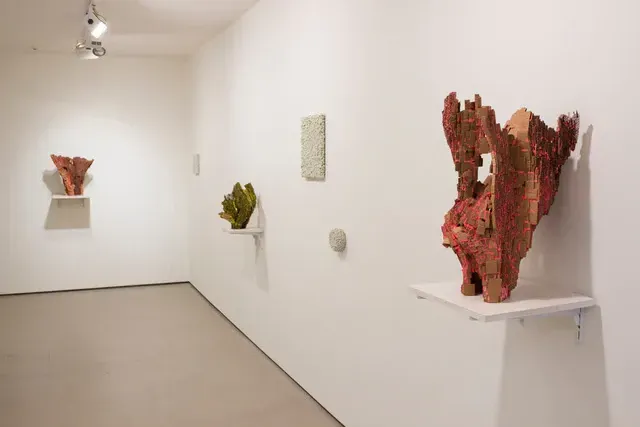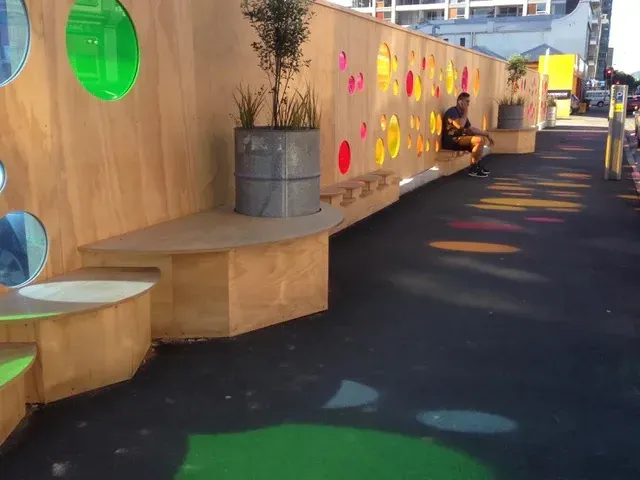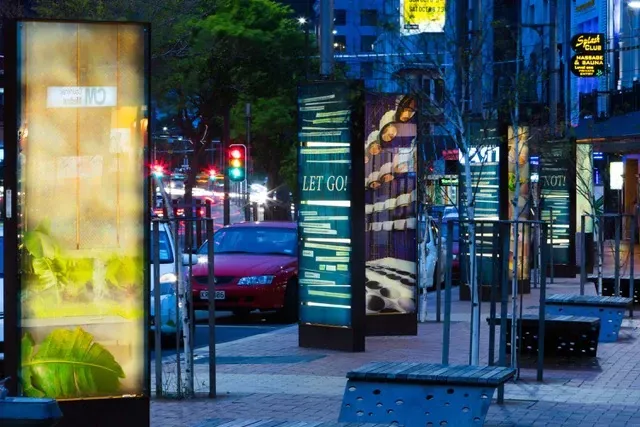Alternative Architecture
Written by
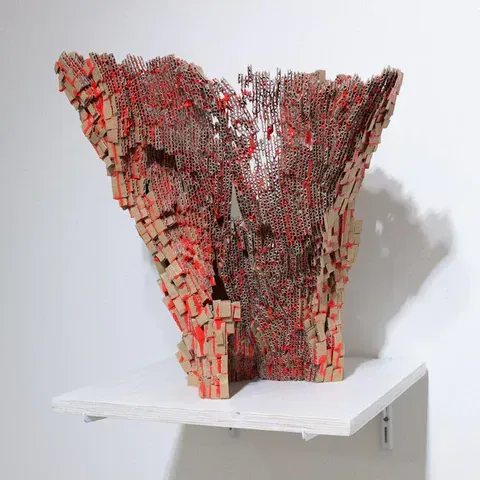
They could be coral growths, flames, or body parts. They are waving, twisting, turning - solid on their feet yet fanning out, finding muscular new shapes. Like hopeful hand signals.
These sculptures by Ruth Thomas-Edmond might at first be reminiscent of cavity-filled hulks of urban modernist ruins - like remnants of the Twin Towers. Yet bound together by fluoro daubs of paint they prove to be as bright in outlook as they are disturbing. An experimental architecture, returning in the abstract to the fibrous organic strength of nature.
This is new work by Thomas-Edmond at Wellington’s Bartley and Company gallery (on show with Claudia Jowitt until 28 October). The artist works with small rectangles of standard box cardboard, building up urn sized sculptures patch upon patch, with the paint as glue. Full of air, the cardboard proves to be as cellular as honeycomb.
With cardboard and in drawings Thomas-Edmond has, since graduating from Elam School Fine Arts, Auckland in 2005 been working in this labour intensive way creating new networked structures. In public galleries like Auckland’s Te Tuhi and City Gallery Wellington they have resembled large heaps. Yet what I love with these smaller works is their sense of stature; a community of many small pieces together rising, animated as if – like the sculptor Giacometti’s rugged, eroded figures – about to walk, or at the very least face the winds of change.
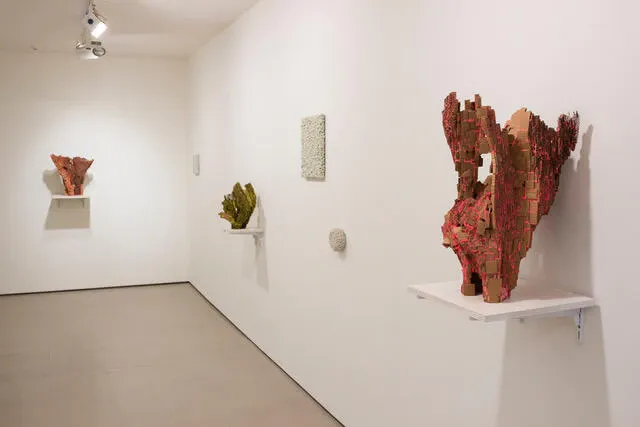
In scale, abstraction and fractured perspectives they’re reminiscent of modernist sculpture, yet speak of a new time, when the towers of our cityscapes don’t always gleam with promise. The colour of Thomas-Edmond’s paint - hot pinks, yellows, reds and blues - have a flash of the fluoro safety vests and ‘danger’ tape you might find around a construction site, but they also speak to me as feminine counter to the masculine palette that dominates the city.
Ruth Thomas-Edmond is one of a group of artists working at Tory Street Studios in the Wellington CBD (which I covered in this article in May). This year she and fellow studio member Kirsty Lillico worked with Wellington City Council to create a design for the hoardings across from their studio in Lower Tory. This has been erected following the demolition of the dull, functional concrete grid of the Readings Carpark building which suffered substantial earthquake damage. It’s interesting considering this design in relation to Thomas-Edmond’s sculptures and Lillico’s own work (based on architectural drawings a Lillico work that touches on the history of inner city social housing was awarded the 2017 Parkin Drawing Prize in August).
This week in Wellington for the Shared Lines programme is a host of artists and artwork from Christchurch, Kaikoura and Japan, to exhibit and discuss the role of artists’ post-earthquakes in urban resilience. Included are two large fishing net works, Sora-Ami by Japanese artist Yausaki Igarashi hung in the Wellington waterfront lagoon, which in their networking of space through knitting speak to our connections across the oceans - making space for the values of community building through art and tradition beyond the built environment.
Lillico and Thomas-Edmond’s hoarding work is an assertion of the artist’s role in this space in Wellington – how artists can pick up the spatial opportunity an earthquake or an economic downturn can provide to explore ways our cities can be more liveable and people-friendly (more reimagining is due to be staged in Lower Tory Street soon).
Thomas-Edmond and Lillico’s design sees the Tory Street hoarding peppered with circular portholes of varying size, in bright colours reminiscent of Thomas-Edmond’s sculptures. They are accompanied by a series of inbuilt stepped circular seats that enable young people to see through the higher portholes, providing a new space of play and rest. The portholes and seats bubble up in a jazzy irregular rhythm, much like fungi might decorate the base of a tree.

With the carpark building gone, once dim Tory Street has been opened up to the light. In the afternoon it streams through the bubbles creating bright spots on the streets, and dancing over pedestrians and cars. In a simple direct way the design transforms the vacuum of space of what would otherwise be just another desultory car-parking lot, energising the public street next to it. It’s also a new way for Wellington City Council to work with artists and property owners. The work has been funded by Readings and developed with them.
Thomas-Edmond and Lillico’s coloured spots are like a daytime recollection of the theatrical lighting of nearby Courtenay Places many bars and clubs. That Wellington nightlife has its dark side, with particular concerns often voiced for the safety of inebriated young women.
A block away are the Courtenay Place Lightboxes – another strong city urban design intervention – which, now ten years old, provides a strongly programmed high quality exhibition space, managed by council. Just down the road from strip club Mermaids, you might note, the lightboxes are currently host to another kind of daylighting.

‘New nightclub for Courtenay Place’ has been created by Lightreading (the collaborative identity of Sonya Lacey and Sarah Rose) with architects Susana Tore and Raphaela Rose. Rather than dwell on the negative aspects of darkness, the project talks to the idea of designing a “fictitious, new, and socially progressive nightclub complex for Courtenay Place” based on interviews with women who’ve played roles in helping shape Wellington’s nightlife. It recognises another side of nightlife: the spaces women have held and created, in the face of the male-dominated pub scene and in environments that remains largely designed and controlled by men. The nightclub, this project beautifully asserts, remains an experiential space where stereotypical norms can shift.
Lightreading have been exploring propositions for progressive nightclub complexes with contributors in their publication series Ultra Vires. In Courtenay Place, the lightboxes operate like pages in a giant scrapbook. In the first panel in a text introduction, we’re given some ideas for what a progressive nightclub designed by women might look like: meandering stairs and glass enclosed bathrooms. But we’re then told “the final form cannot be known, as it is the manifestation of changing desires”, embracing an “unending fluidity that disintegrates rigidly assumed gender, race and class roles.” That’s reflected in the dreamy surreal images on one side of the lightboxes, that like a series of curtains suggests spaces rather than provide concrete suggestions. On the reverse side is a collage of snippets of text, these include interview excerpts and questions around the politics of exclusivity, the power in the nightclub of the gaze, and how the memory of women is preserved in public space.
There’s been an increasingly strong strain of artist projects exhibited in the Courtenay Place Lightboxes that give space to the less visible histories of the Courtenay Place area. It’s a vital role art now plays in public space – opening up and questioning the surrounding built environment - and that is often being led by Māori and women.
In this area of the Wellington CBD that can be tracked back to other significant public artwork. In Cathryn Munro’s ‘Per Capita’, on the corner of Tory and Cable Streets, it’s the cameo-like silhouettes of young women, not men that have prominence. And most notably, across the road from the lightboxes on the corner of Dixon and Taranaki Street is Shona Rapira-Davies early 1990s redesign of Te Aro Park. With its horizontal rather than vertical emphasis and use of ceramics and plants, it recognises the power of the land and mana whenua but also a female, Papatuanuku (earth mother) presence as guardians. Part of the site of the original Te Aro Pa, Rapira-Davies’ Te Aro Park was an act by an artist that was hard-fought for and that still, in the midst of a city, feels “socially progressive”.
